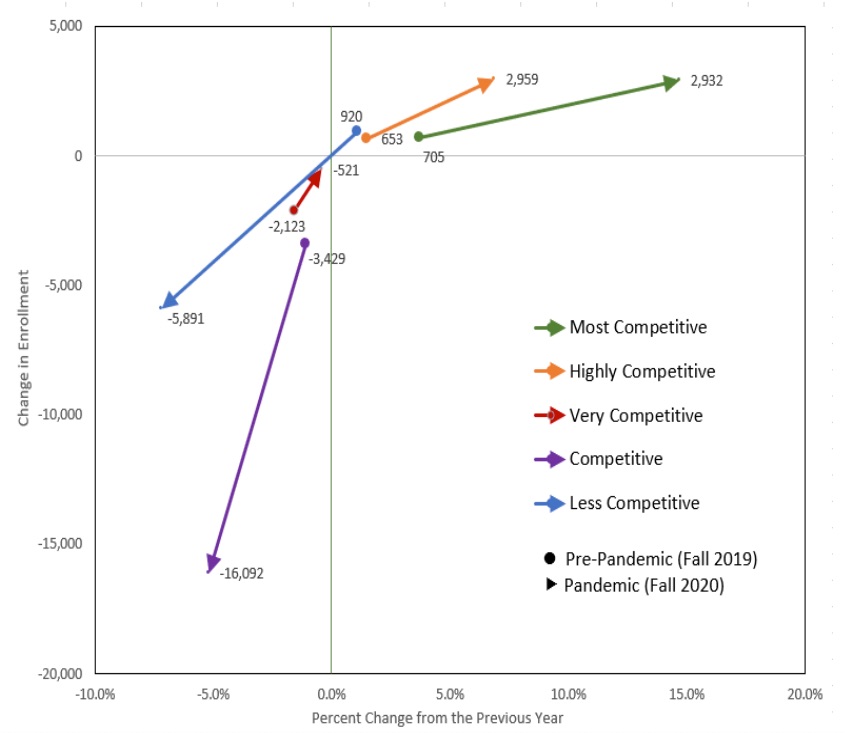High School Benchmarks 2021 Report Features Gap Year Enrollment Analysis
- NEWS HOME
- »
- 2021
High School Benchmarks 2021 Report Features Gap Year Enrollment Analysis
Fewer Class of 2020 High School Gap Year Students Enrolled in College in Fall 2021
HERNDON, VA – (DECEMBER 3, 2021) – The National Student Clearinghouse Research Center announced today the ninth annual High School Benchmarks report, which features a special analysis of gap year enrollment for 2020 high school graduates who waited until fall 2021 to enroll in college.
“We found no upswing in gap year college enrollment this fall,” said Doug Shapiro, Executive Director of the Research Center. “Only 2% of those who did not enroll in college immediately after high school in 2020 showed up as gap year enrollments in fall 2021, strongly suggesting that the pandemic-related concerns that kept many students out of college last year have not abated.”
Key findings include:
- The overall gap year college enrollment rate for the class of 2020 declined slightly from previous classes, from 2.6% for 2018 and 2.2% for 2019, to just 2.0% of the 2020 class who had not enrolled in their first fall.
- The gap year enrollment rate in fall 2021 is low regardless of high school characteristics, ranging from 1.1% to 3.2%, a stark contrast with the patterns of disparity found in immediate college enrollment for the class of 2020.
- Fall 2020 enrollment trend data for 2020 high school graduates, in approximately 8,400 high schools nationwide, further confirms the pandemic effect of the Research Center’s preliminary report issued in March 2021 (See Appendix B, Table 1 for details).
The COVID-19 gap year analysis section of the High School Benchmarks 2021 report provides preliminary estimates of the impact of COVID-19 on gap year enrollment for the 2019 and 2020 graduating classes of high school seniors, compared to the pre-pandemic baseline of the 2018 class. The analysis covers nearly 860,000 graduates and 3,500 high schools that consistently reported their graduates within a similar time frame each year from 2018 through 2020. It shows their immediate fall and gap year (following fall) enrollments at the approximately 67 percent of colleges that reported enrollment data as of October in each year from 2019 through 2021.
The High School Benchmarks 2021 – National College Progression Rates examines college enrollment for the high school graduating class of 2020, persistence for the class of 2018, and completion for the class of 2014. These data are the most relevant benchmarks for monitoring and evaluating progress in assisting students to make the high school to college transition and earn a credential in a timely manner. In spring 2022, the Research Center will issue a Special COVID-19 Analysis on the high school class of 2021 for their enrollment in fall 2021.
About the National Student Clearinghouse® Research Center™
The National Student Clearinghouse Research Center is the research arm of the National Student Clearinghouse. The Research Center collaborates with higher education institutions, states, school districts, high schools, and educational organizations as part of a national effort to better inform education leaders and policymakers. Through accurate longitudinal data outcomes reporting, the Research Center enables better educational policy decisions leading to improved student outcomes.
The Research Center currently collects data from more than 3,600 postsecondary institutions, which represent 97% of the nation’s postsecondary enrollments in degree-granting institutions, as of fall 2019. Clearinghouse data track enrollments nationally and are not limited by institutional and state boundaries. To learn more, visit https://nscresearchcenter.org.
###
